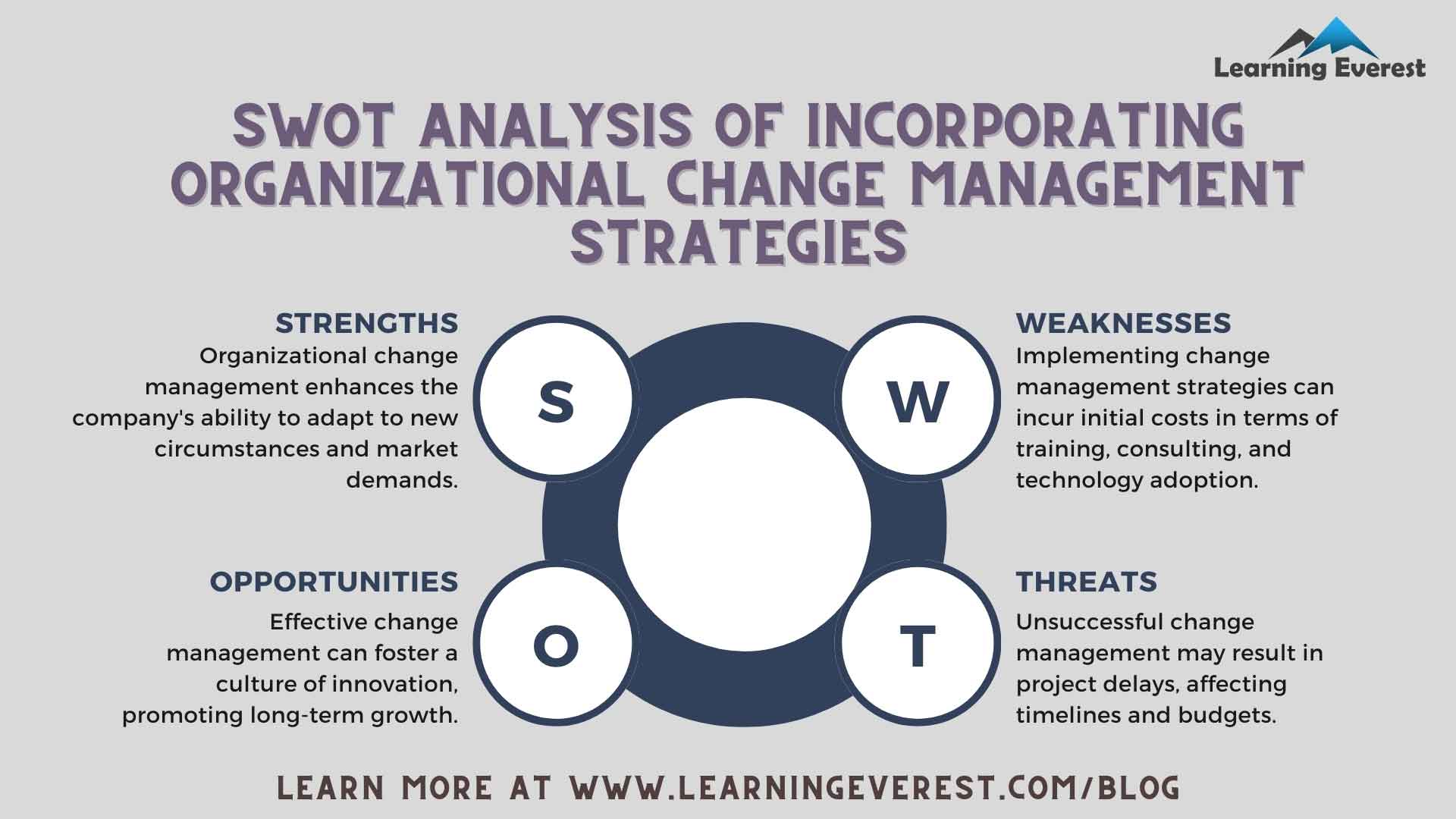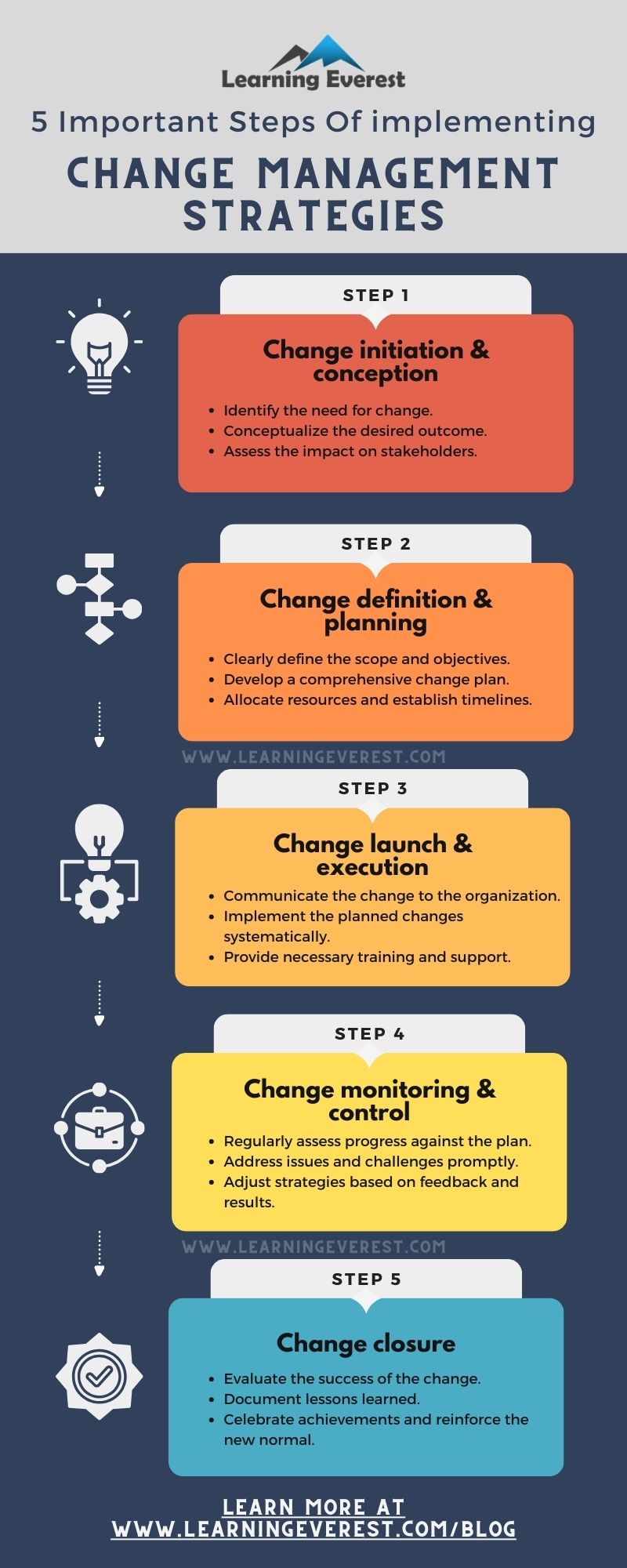Organizational change management strategies play a pivotal role in navigating the complex landscape of contemporary business environments. In an era marked by rapid technological advancements and dynamic market forces, organizations that master the art of change management are better positioned to thrive amidst uncertainty and secure sustainable growth. This blog explores the multifaceted realm of organizational change management, delving into strategies that facilitate seamless transitions, enhance adaptability, and foster a culture conducive to innovation.
Table of Contents
- Why do we need organizational change management strategies?
- What are the best organizational change management strategies?
- Infographic
- Knowledge Check!
- Frequently Asked Questions (FAQs)
- 1. What is an organizational change management strategy?
- 2. What are the 6 types of organizational change?
- 3. What are the 5 C’s of successful organizational change?
Why do we need organizational change management strategies?
Organizational change management strategies are crucial for several reasons. They help mitigate resistance to change, enhance employee morale and productivity, ensure a smooth transition, and maximize the chances of successful implementation of new initiatives. These strategies provide a structured approach to guide organizations through the complexities of change, fostering adaptability and reducing disruptions.

SWOT Analysis of Incorporating Organizational Change Management Strategies
Let’s delve deeper into each aspect.
1. Mitigate Resistance to Change
Change often triggers uncertainty and resistance among your employees. Change management strategies help identify potential sources of resistance in your organization and address them proactively. How can you do it? Communication plans, stakeholder engagement, and involvement in decision-making can alleviate concerns, fostering a more positive perception of the changes.
2. Enhance Employee Morale and Productivity
When your employees understand the reasons behind the change and feel involved in the process, it positively impacts their morale. Change management strategies focus on creating a supportive culture, providing training and resources, and recognizing and rewarding contributions during the transition. This helps maintain or even boost productivity.
3. Ensure a Smooth Transition
Organizational change often involves multiple interconnected components. Change management strategies include detailed planning and coordination to ensure a seamless transition from the current state to the desired future state. Solution? Timely identification of potential challenges and the development of contingency plans contribute to a smoother process.
4. Maximize Chances of Successful Implementation
Success in implementing new initiatives relies on more than just the technical aspects of the change. Change management strategies emphasize aligning people, processes, and technology to the organizational goals. Continuous monitoring, feedback loops, and the ability to adapt strategies based on real-time insights contribute to increased chances of successful implementation.
Organizational change management strategies address the human side of change, recognizing that successful transitions require more than just structural adjustments. By focusing on communication, employee engagement, and comprehensive planning, these strategies pave the way for a more positive and effective organizational transformation.
Let’s discuss this in detail.
What are the best organizational change management strategies?
The effectiveness of organizational change management strategies can vary based on the specific context and nature of the change. However, some widely recognized best practices include:
1. Clear Communication
Transparent and consistent communication is an essential organizational change management strategy. Clearly articulate the reasons for the change, expected outcomes, and how it will impact employees. Therefore, keep the lines of communication open between you and your employees. Make yourself open to queries, hold team meetings with your employees, and invite your team to come see you and talk through their concerns or thoughts in a safe atmosphere.
2. Employee Involvement
It is helpful to be as transparent as possible with your employees – even if you can’t provide them all of the details, being upfront about the pieces you can share will go a long way toward helping your staff feel more comfortable. So, involve employees in the change process. Seek their input, listen to their concerns, and make them active participants. This fosters a sense of ownership and reduces resistance.
3. Leadership Support
Strong leadership support is crucial. Leaders should visibly champion the change, demonstrate commitment, and model the desired behavior. Their endorsement provides credibility and guidance. A strong leader can help the team weather the storms of change with preparedness and clear-sightedness, no matter how challenging they might be.
4. Comprehensive Planning
A well-thought-out strategy enhances the likelihood of a smooth transition. Help your employees understand where the organization is, where it’s been, and where it’s going. How does the change play into the organization’s history, and how is it going to shape its future? Conveying this clearly will demonstrate the strategy behind the change and will help your employees see how it fits into or is evolving from the business model they have become accustomed to.
5. Training and Development
When the change involves modification in technologies or processes, provide adequate training to equip employees with the skills needed for the new environment. This helps build confidence and minimizes disruptions to productivity. Ensure that you convey that this training program will be available when the change is announced to avoid employees feeling like they’ll be left behind due to lack of experience.
6. Feedback Mechanisms
Establish feedback channels to understand how employees are adapting to the change. Regularly assess progress, address concerns promptly, and make adjustments to the strategy as needed. And continually touch base with key stakeholders to gauge their perspectives and get any relevant feedback. This provides a basis for evaluating the impact and adjusting strategies as needed.
7. Cultural Alignment
Ensure that the change aligns with the organization’s overall values and culture. A cultural fit facilitates acceptance and integration of the new practices among the employees.
8. Recognition and Rewards
It is important to recognize and reward individuals and teams for their contributions to the change process. Positive reinforcement reinforces desired behaviors and creates a positive atmosphere. Therefore, as an organization, you need to reward the employees as a form of recognition.
9. Sustainable Change
Implement changes incrementally when possible, allowing employees to adjust gradually. Sustainable change is more likely when it is integrated into the organization’s DNA over time.
10. Measurable Outcomes
Once the change process is in motion, it is important to maintain consistent oversight over the implementation of the change to ensure that things go smoothly and that you will ultimately be successful. Keep a close eye on potential problems and address any issues in a timely manner. Always define metrics to measure success and continually monitor them to make sure that you are staying on track.
Remember, these organizational change management strategies are interconnected and should be adapted to the specific circumstances of each organizational change. Flexibility and a continuous improvement mindset are key to navigating the complexities of change successfully.
Infographic
Was this article helpful?
The following article can also be a helpful guide as you get started:
How to Change Employee Behavior
Or, talk to us to learn more about implementing change management strategies. BOOK A DEMO TODAY!
Knowledge Check!
Frequently Asked Questions (FAQs)
1. What is an organizational change management strategy?
Transparent and consistent communication is an essential organizational change management strategy. Clearly articulate the reasons for the change, expected outcomes, and how it will impact employees.
2. What are the 6 types of organizational change?
The six types of organizational change are strategic, structural, technological, process-oriented, people-oriented, and cultural changes.
3. What are the 5 C’s of successful organizational change?
The 5 C’s of successful organizational change are Culture, Communication, Courage, Conviction, and Compassion.






